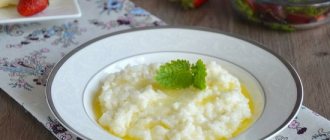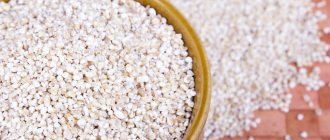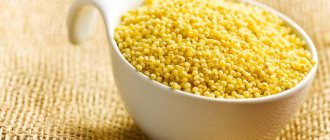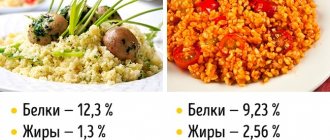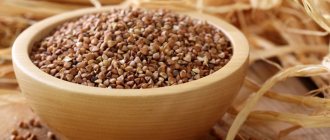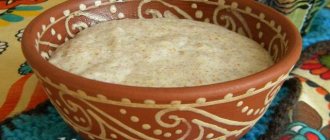Rice is one of the oldest grain crops on the planet. Scientists believe the plant is at least 5,000 years old and is a staple food for more than half the world's population. The main consumers of rice are residents of South and East Asia. White grains are most commonly consumed, but brown (unpolished) rice has become increasingly popular in the Western world in recent years as a healthy food.
general characteristics
Content:
- general characteristics
- White vs brown
- Useful components
- Beneficial features
- Cautions
- How to choose the right rice
- What is it suitable for?
- Rice water in cosmetology
Rice is an annual cereal plant popular in Asian countries. It is believed to be the second most common cereal on the planet (after corn). It is grown on all continents except Antarctica. There are more than 40 thousand varieties of this cereal, but the white or unpolished product is most often used as food. Depending on the method of grain processing, its taste varies. Therefore, different varieties of rice are used for different dishes.
In addition, in cooking it is customary to distinguish rice by the length of the grain. Thus, in Indian and Chinese cuisine, long-grained grains are more often used; in Western countries, short or round grains are preferred.
In addition to the traditional white grain, other types of rice are also used for food: brown, red, purple and even black.
Calorie content
There are many different diets in which this product is the basis. These can be quite strict programs for weight loss, when you can’t eat anything other than boiled grains, or more gentle ones, which only allow you to combine them with other products.
100 grams of dry rice contains 360 kilocalories. This is quite a lot to promote weight loss, but the whole point is that during cooking, grains absorb a large amount of water, which significantly reduces the final calorie content. When boiled, the same 100 grams already contain 115 calories.
In addition, the composition also contains about 25 grams of carbohydrates, contains phosphorus, potassium, calcium and B vitamins, and is almost completely free of proteins and fats.
White vs brown
White rice is a refined product, free of bran and germ. These procedures can improve the quality of food, extend the shelf life of grain, and improve its taste. But, as a rule, all this is achieved by reducing the nutritional value of the product.
Brown rice is an intact whole grain rich in fiber, minerals, vitamins and antioxidants. In addition, unrefined grains tend to have a lower glycemic index, which means they are more beneficial for diabetics. But rice bran, among other things, is a source of so-called antinutrients. One of them is phytic acid. In addition, heavy metals can be concentrated in the outer shell of rice (if the grains were grown in contaminated areas).
Useful components
Carbohydrates
Rice mainly consists of carbohydrates (approximately 90% of the total mass), which are mainly represented by starches. Starch is the most common form of carbohydrates and is composed of amylose and amylopectin. Both of these substances have different properties that determine the structure and digestibility of the product. Rice rich in amylose (such as basmati) does not stick together after cooking. In addition, amylose slows down the digestion of starch, that is, it contributes to the creation of so-called resistant starch.
In contrast, rice that is low in amylose and amylopectin turns into a sticky substance when cooked. These types of product are suitable for rice puddings, risotto, and for preparing Asian dishes. However, such rice is digested faster and causes sharp spikes in blood sugar levels, which is extremely undesirable for people with diabetes.
Cellulose
Traditional white rice is a low-fiber product (no more than 0.3%), which cannot be said about brown rice, which consists of almost 2 percent dietary fiber. However, both types of rice may contain resistant starch. In its functions, this substance largely resembles fiber and also serves as “food” for beneficial intestinal microflora. In the colon, resistant starch promotes the creation of short-chain fatty acids (butyrates), which improve gut health and prevent cancer.
Vitamins and minerals
The nutritional value of rice is usually determined by the type of product and the cooking method. Many vitamins and minerals are concentrated in the bran and germ, which are exclusively components of brown rice.
So, rice contains:
- manganese is an antioxidant, found in almost any whole grain, important for metabolism, growth and development of the body;
- selenium is a mineral that is the main part of selenoproteins, which are responsible for a variety of functions in the body;
- thiamine (vitamin B1) – necessary for proper metabolism, supports the functionality of the heart, muscles, and nervous system;
- niacin (vitamin B3) – important for most redox reactions in the body (soaking rice in water before cooking will help increase the absorption of the vitamin);
- Magnesium – found in brown rice, important for preventing many chronic diseases;
- Copper – a deficiency of the mineral causes heart disease.
In addition to the components already mentioned, rice contains many plant compounds that are important for maintaining health. The highest levels of antioxidants were found in pigmented cereal varieties. But white rice is absolutely not suitable as a source of these beneficial substances.
Plant compounds in rice:
- lignins - during metabolism they are converted into enterolactone, which performs a variety of functions in the body;
- ferulic acid – a strong antioxidant found in rice bran, protects against cancer, diabetes, and cardiovascular diseases;
- phytic acid is an antioxidant found in unpolished grains, but excessive consumption can impair the absorption of iron and zinc.
Nutritional value of rice per 100 g of product
| Calorie content | 130 kcal |
| Squirrels | 2.5 g |
| Fats | 0.2 g |
| Carbohydrates | 28.7 g |
| Vitamin B1 | 0.16 mg |
| Vitamin B2 | 0.02 mg |
| Vitamin B3 | 1.5 mg |
| Vitamin B5 | 0.5 mg |
| Vitamin B6 | 0.06 mg |
| Folic acid | 59 mcg |
| Calcium | 1 mg |
| Iron | 1.46 mg |
| Magnesium | 8 mg |
| Phosphorus | 33 mg |
| Potassium | 26 mg |
| Zinc | 0.4 mg |
| Manganese | 0.36 mg |
| Selenium | 7.5 mcg |
Calories in white rice
White rice is a popular cereal crop that is widespread in Asian countries. It contains the optimal amount of biologically active components, minerals and vitamins for the human body:
- PP;
- H;
- E;
- D;
- B6;
- B5;
- B2;
- B1;
- sodium;
- phosphorus;
- iodine;
- iron;
- zinc;
- calcium;
- potassium.
Rice cereal contains fiber and starch, which ensure the normal functioning of the digestive system. Slightly soluble carbohydrates provide an influx of energy, suppressing hunger for a long time. The calorie content of rice boiled in water or steamed does not exceed 130 kcal (100 g). It does not lose its taste within 72 hours after preparation.
Types of white rice (depending on the shape of the grains):
- Long. The grains are thin, up to 7 mm long. Cooked rice of this variety retains most of the nutritional components during heat treatment. The grains do not stick together, absorbing a minimal amount of liquid. Slightly hard, suitable for preparing salads, first and second courses.
- Average. The grains are oval, wide and small. Absorbs a lot of liquid and becomes soft fairly quickly. The grains stick together during cooking, so this variety is suitable for paella or risotto.
- Round. Small round grains, no more than 3-5 mm long, do not cook for long. Puddings, casseroles and milk porridges turn out quite sticky.
The calorie content of rice (kcal) can be affected by gluten, a protein that can cause allergic reactions. The hypoglycemic index of boiled cereal ranges from 60-75 units. The daily intake of the product is no more than 250 g. Children can be given steamed varieties of rice, which must first be boiled in water with or without salt.
The product norm per day is 100-150 g. The nutritional value of dry, thermally unprocessed cereal is quite high - about 250 kcal.
During stewing or cooking, most of the starch is washed out, so the calorie content is reduced by almost 2 times. If you add a little butter or whole milk to the water, the grains will be more nutritious. Energy value increases in direct proportion to the amount of carbohydrates and fats.
Boiled in water
Cereal cooked in water without salt has minimal nutritional value. There are no more than 115 kcal per 100 g of finished product. The nutritional value of boiled rice can increase depending on the presence of various additives in the independent dish, such as:
- salt;
- vegetable oil;
- butter;
- spices.
Table of calorie content and ratio of BJU:
| Supplements | Carbohydrates | Squirrels | Fats | The nutritional value |
| Vegetables | 24 | 2,3 | 3,13 | 130 |
| Vegetable oil | 26 | 2,1 | 2,3 | 206 |
| Butter | 24 | 2,1 | 2,3 | 191 |
Before cooking, the cereal must be washed several times until the water becomes completely clear. Pour 200-250 ml of liquid into a bowl with a thick bottom and walls. After boiling, the cereal crop is simmered over low heat. The cereal is considered ready if it has completely absorbed all the liquid. Stir the cereal periodically to prevent the grains from sticking together and burning to the bottom of the container.
We recommend checking out Chamomile Tea
On water with salt
If you add a little iodized salt to the water with cereal, the nutritional value of the side dish or independent dish will increase slightly (up to 125-128 kcal). Cereals cooked in salted water with the addition of a small amount of vegetable oil are not recommended for people on diets.
When cooked, cereal quickly absorbs liquid, so add salt immediately before cooking.
To reduce cooking time, the cereal can be pre-soaked in cold or hot water. To do this, the cereal, washed several times, is poured into a deep bowl and filled with liquid (ratio 1:3). The cereal is left for several hours; it is not necessary to cover the container with a lid.
Salt, like any other seasoning, enhances the taste of a dish.
When soaking, it is not added to the water. As the salt dissolves, it penetrates into the grains, making their taste more piquant. It is preferable to throw rice into boiling water. In this case, the salt ratio is no more than 1 tsp. for 1 l. liquids. It is not necessary to cover the pan with a lid.
During the cooking process, it is necessary to monitor the amount of liquid in the container. If it has boiled away, pour hot water over the cereal and cook for a few more minutes.
Beneficial features
Rice is considered one of the healthiest foods in the world. Representatives of different culinary schools argue in what form and in combination with what products rice tastes best. But no matter what dish you prepare from this cereal, its beneficial properties will not change. Here are some of the main benefits of this product.
Energy source
Since rice is rich in carbohydrates, it acts as a “fuel” in the body, supplying energy to the muscles and also activates the brain.
In addition to carbohydrates, this cereal contains a complex of vitamins and minerals, which are also important for active life and improved metabolism.
Heart Health
Cardiovascular diseases, such as heart attacks and strokes, are the leading causes of death worldwide. Observations have shown that consuming whole grains helps reduce this figure. Researchers followed hundreds of men who ate whole grains for breakfast every day for 5 years. As a result, their chance of developing fatal cardiac diseases decreased by almost 20 percent. A similar study in women yielded even more encouraging results: the risk of cardiovascular disorders decreased by more than 30 percent. Other studies have shown that whole grains have a beneficial effect on vascular health in people with obesity or diabetes.
Stable blood pressure
Rice is low in sodium and is considered a good food for people with high blood pressure. Sodium can cause spasms and constriction of blood vessels, which as a result increases the stress on the heart muscle. Sodium-free foods can be considered foods that prevent atherosclerosis, heart attack, stroke and some other cardiovascular diseases.
Cancer Prevention
Whole grain rice is rich in insoluble fiber, which researchers say may reduce the risk of developing various types of cancer. Scientists also suggest that this substance can slow down the metastasis of cancer cells. In particular, it is known that dietary fiber is an excellent preventative against colorectal cancer and oncological degeneration in intestinal tissues.
However, in addition to fiber, rice contains natural antioxidants such as vitamins C and , phenolic compounds and flavonoids, which protect the body from the harmful effects of free radicals. Thus, they prevent mutations at the cellular level and increase the ability to resist dangerous substances and organisms.
Alzheimer's protection
Brown rice is rich in many beneficial substances that stimulate the activity of neurotransmitters. The result of this effect is the prevention of Alzheimer's disease or alleviation of its manifestations. Due to its special chemical composition, wild rice has been shown to stimulate brain cells, increase their protective abilities, and also suppress the harmful effects of free radicals and toxins, which ultimately protects against the development of dementia.
Benefits for digestion
For centuries, rice husks have been used as a remedy against dysentery and also as a diuretic. The Chinese consider this cereal indispensable for people with digestive problems, stomach diseases and lack of appetite. In addition, Easterners use a decoction of rice husks as a means of losing weight and removing toxins from the body. And varieties rich in fiber prevent chronic constipation.
Source of vitamins
The grains of this cereal are a good source of vitamins and minerals. In particular, this product supplies the body with niacin, thiamine, riboflavin, vitamin D, calcium, and iron. These substances are indispensable for the immune system and proper metabolism.
Skin health
Scientific studies of the properties of rice grains have discovered that flour from this grain effectively treats skin diseases.
Residents of Indochina have been using rice ointments to treat skin inflammation for thousands of years. Phenolic compounds found in rice (especially brown or wild rice) have anti-inflammatory properties. In addition, antioxidants protect against early wrinkles.
Other benefits of rice:
- does not contain gluten and cholesterol;
- quickly restores energy;
- improves intestinal motility;
- slows down the aging process;
- activates metabolism;
- improves digestion;
- reduces blood pressure;
- promotes weight loss;
- strengthens the immune system;
- prevents cancer and heart disease.
Disadvantages of rice
This wonderful and useful culture has its downsides and disadvantages. First of all, it is categorically not recommended to use it in large quantities in the presence of extreme obesity, as well as for people who have a tendency to constipation - instead of benefit, it can only harm the body and aggravate the condition.
In addition, consumption can also be harmful for colic. There is also individual intolerance to the product.
An excessive amount of grains is also contraindicated in that it contributes to a decrease in sexual function in men.
It can be harmful even to a completely healthy person in significant doses, as it tends to provoke constipation and have a detrimental effect on the cardiovascular system of the body. This especially applies to its white variety. In its unrefined form, its shell contains substances that reduce the ability to absorb useful elements such as calcium and iron.
Cautions
Type 2 diabetes is one of the reasons to avoid certain types of white rice as a product with a high glycemic index. Also, a study involving more than 64 thousand Chinese women showed that it is enough to eat 300 g of white grains daily to almost double the risk of developing diabetes. Therefore, diabetics are advised to consume only brown rice.
The second possible danger of this cereal is heavy metals, which can concentrate in the bran. For this reason, brown rice may be more dangerous than milled rice.
Chemical composition and trace elements of rice
Rice is one of the main grains in the Russian diet, along with buckwheat, oatmeal, peas and millet. It is used as a side dish, added to salads, soups, minced meat and pies. How many calories, proteins, fats and carbohydrates are in rice?
100 g of dry product contains:
- 300 kcal;
- 7.6 g protein;
- 2.6 g fat;
- 62.3 g carbohydrates.
The composition contains fiber - 9.8 g per 100 g of cereal.
The glycemic index of rice cereal is 60 units.
Microelements - magnesium, phosphorus, selenium, copper and manganese - satisfy the daily requirement for these elements by more than 30%.
Important! Rice satisfies 20% of the daily requirement for essential amino acids.
How to choose the right rice
The general rules for purchasing rice are the same as when choosing other cereals. It should be dry, without mold or rotten smell. It is better to take the product in a sealed package, but it is important to check its integrity.
But the process of choosing rice does not end there. Since there are many different varieties of this product, it is good to know which type is best suited for which dish. Here are some tips on how to choose rice.
- Proper rice looks like frosted glass.
- White, like chalk, is a sign of unripe grains; it boils quickly.
- Yellow grains – the product was kept moist for a long time before packaging. It may contain mycotonsins and carcinogens.
What is it suitable for?
Round grain Japonica - sushi.
Round or medium-grained Arborio - porridge, risotto.
Round or medium-grained Krasnodar - soups, milk porridges.
Long-grain Basmati (considered the best of all varieties) – side dishes, oriental dishes, pilafs.
Long-grain Jasmine - for cooking under the lid, crumbly side dishes.
Long-grain Indica – side dishes, pilafs, salads.
Wild rice (black) – side dishes, salads.
Unpolished (brown) – side dishes, salads, suitable for cooking in large amounts of water.
Red – side dishes, salads.
Classification by grain shape:
- long-grain – oblong, up to 8 mm, crumbly after cooking, used for soups, side dishes, salads, appetizers;
- medium-grain – round, up to 6 mm, sticky after cooking, but does not form lumps, used for porridges, soups, risotto;
- round grain – round, up to 5 mm, sticks together after cooking, used for porridges, soups, casseroles, puddings, desserts, and as a filling for pies.
